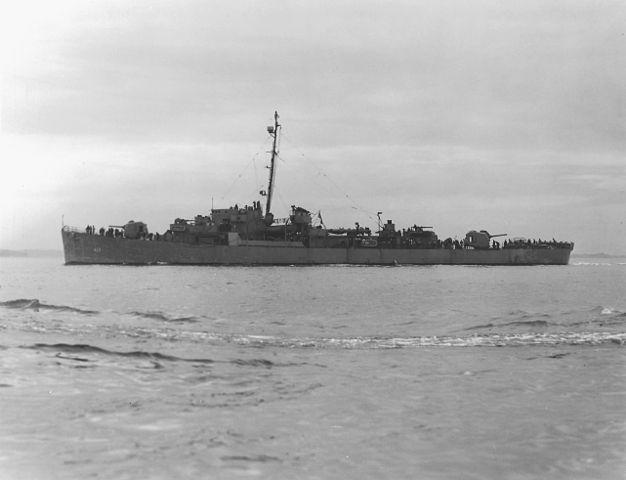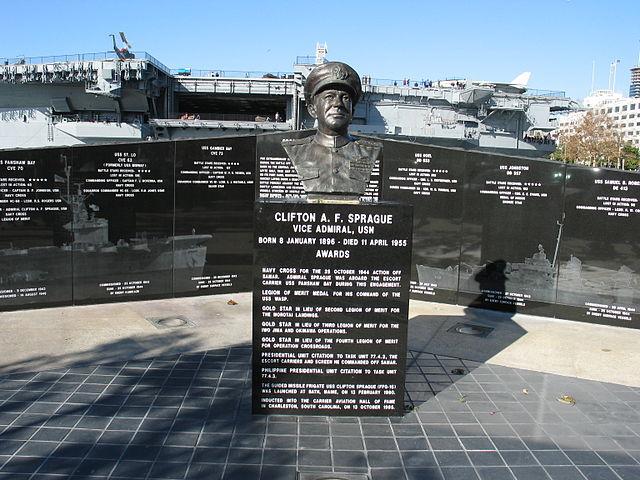-
Moderator
(M1 Garand/M14/M1A Rifles)


Oct. 25, 1944 off Samar Island
"In no engagement of its entire history has the United States Navy shown more gallantry, guts and gumption than in those two morning hours between 0730 and 0930 off Samar."
— Samuel Eliot Morison, History of United States Naval Operations in World War II, Volume XII, Leyte
As the invasion of the Philippines was being conducted, the Japanese created a battle plan to oppose it; essentially a Naval Banzai charge. The last elements of the combined fleet were to work in three groups. Two were to force action and annihilate the thin-skinned invasion vessels, mostly cargo ships and the tiny "jeep" escort aircraft carriers, destroyers, and destroyer escorts detailed to guard them. One Japanese element consisting of empty hybrid cruiser/aircraft carriers was to serve as a decoy to get the American heaviest out of play. The decoy worked and Admiral William Halsey took off in pursuit. One of the Japanese attack elements was virtually destroyed but the other, consisting of battleships, cruisers, and destroyers headed, by Admiral Takeo Kurita, made its way towards the sheep pen of the thin-skinned U.S. invasion force on the morning of Oct.24. The Navy forces guarding the invasion fleet were broken into three groups called Taffy 1, 2, & 3.
created a battle plan to oppose it; essentially a Naval Banzai charge. The last elements of the combined fleet were to work in three groups. Two were to force action and annihilate the thin-skinned invasion vessels, mostly cargo ships and the tiny "jeep" escort aircraft carriers, destroyers, and destroyer escorts detailed to guard them. One Japanese element consisting of empty hybrid cruiser/aircraft carriers was to serve as a decoy to get the American heaviest out of play. The decoy worked and Admiral William Halsey took off in pursuit. One of the Japanese attack elements was virtually destroyed but the other, consisting of battleships, cruisers, and destroyers headed, by Admiral Takeo Kurita, made its way towards the sheep pen of the thin-skinned U.S. invasion force on the morning of Oct.24. The Navy forces guarding the invasion fleet were broken into three groups called Taffy 1, 2, & 3.
As soon as airmen aloft spotted the attacking Japanese fleet element, the Taffies and their protected ships were ordered to heave clear. The Taffies furthest from the Japanese attack force, Taffies 1 and 2, were able to get clear but Taffy 3 was left holding the bag of facing the enemy. All the escort carriers launched all their planes that fought against the Japanese force as they approached. The commander of Taffy 3, Admiral Clifton "Ziggy" Sprague, ordered his destroyers and destroyer escorts to turn and protect the jeep carriers from the onrushing Japanese force. Without hesitation the destroyers and escorts with their tiny 5" cannons made smoke to screen the ships they were charged with protecting and turned to take on the attacking force. They were able to score hits on the enemy, who for a while were unable to train their guns low enough to hit the smaller ships. Eventually, however, the larger ships began to score hits. Rather than hitting and exploding, many of the shells simply pierced the light skins of the ships on one side, barreled through the entire width of the ship killing all in the way, and exited the other side. Eventually U.S. Johnston, USS Hoel, escort USS Samuel B. Roberts, and escort carriers Gambier Bay and St. Lo were sunk but with their noses bloodied, Kurita's force turned away.
Johnston, USS Hoel, escort USS Samuel B. Roberts, and escort carriers Gambier Bay and St. Lo were sunk but with their noses bloodied, Kurita's force turned away.

USS Samuel B. Roberts DE-413
It has been called the most mismatched battle ever to be won. In all over 1000 sailors were killed but the vulnerable invasion ships were protected and continued the assault on the Philippines. There is a memorial to Taffy 3 and Clifton Sprague at the waterfront in San Diego.
Read more about it in James Hornfischer's book, Last Stand of the Tin Can Sailors.
Bob
Information
 |
Warning: This is a relatively older thread
This discussion is older than 360 days. Some information contained in it may no longer be current. |
|
Last edited by Bob Womack; 10-29-2016 at 11:55 AM.
Reason: grammer
"It is said, 'Go not to the elves for counsel for they will say both no and yes.' "
Frodo Baggins to Gildor Inglorion, The Fellowship of the Ring
-
The Following 14 Members Say Thank You to Bob Womack For This Useful Post:
25-5,
30Three,
aspen80,
AZPhil,
Bruce_in_Oz,
CINDERS,
ed skeels,
gsimmons,
HOOKED ON HISTORY,
Merle,
oldpaul,
Sarge1998,
sjc,
Youngblood
-
10-25-2016 03:27 PM
# ADS
Friends and Sponsors

created a battle plan to oppose it; essentially a Naval Banzai charge. The last elements of the combined fleet were to work in three groups. Two were to force action and annihilate the thin-skinned invasion vessels, mostly cargo ships and the tiny "jeep" escort aircraft carriers, destroyers, and destroyer escorts detailed to guard them. One Japanese element consisting of empty hybrid cruiser/aircraft carriers was to serve as a decoy to get the American heaviest out of play. The decoy worked and Admiral William Halsey took off in pursuit. One of the Japanese attack elements was virtually destroyed but the other, consisting of battleships, cruisers, and destroyers headed, by Admiral Takeo Kurita, made its way towards the sheep pen of the thin-skinned U.S. invasion force on the morning of Oct.24. The Navy forces guarding the invasion fleet were broken into three groups called Taffy 1, 2, & 3.
Johnston, USS Hoel, escort USS Samuel B. Roberts, and escort carriers Gambier Bay and St. Lo were sunk but with their noses bloodied, Kurita's force turned away.


















 PM
PM






